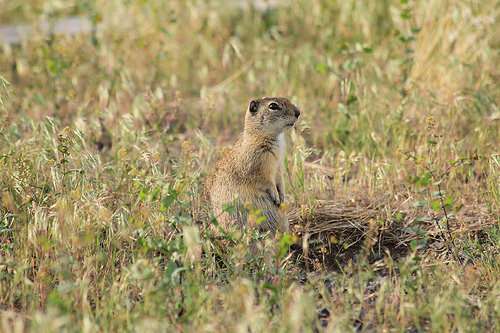Varmint hunters' ammo selection influences lead exposure in avian scavengers

Varmint hunters' choice of ammunition plays a role in the amount of lead that scavengers such as golden eagles could ingest, a new study shows, and offers a way to minimize the lead exposure to wildlife.
Using a new bullet-fragment recovery technique known as "digestion," the research also suggests that radiographs, or X-rays, a common tool for estimating how much of the toxic metal left is behind in shot pests or game animals, tend to produce low estimates.
A team of researchers that included Oregon State University undergraduate student Mason Wagner and U.S. Geological Survey scientists collected 127 Belding's ground squirrel carcasses from alfalfa fields in southern Oregon and northern California.
Eleven western states produce roughly 40 percent of the U.S.'s alfalfa, and burrowing mammals such as ground squirrels and prairie dogs can cause significant yield loss. Shooting the rodents is an important form of pest control as well as a popular recreational pastime throughout the West.
The carcasses are typically left on the fields, where avian scavengers like eagles, hawks and kestrels descend upon the carrion to feed both themselves and their nestlings.
This study looked at how much lead remained in the carcasses and how that correlated with the type of bullet used. Models were also created to estimate from radiographs the amount of lead left in a carcass and the potential effect of the lead on nestlings' mortality, growth and production of an enzyme critical to the blood's ability to carry oxygen.
Results of the study by Oregon State's College of Agricultural Sciences and the USGS were recently published in PLOS ONE.
The research found 80 percent of shot carcasses had detectible fragments of lead. The study also found bullet type didn't have an effect on the number of fragments, but it did influence the mass of the retained fragments. Also, smaller carcasses showed more "pass-through," i.e. less retained lead.
Squirrels shot with high-velocity, high-mass .17-caliber Super Mag bullets, for example, had 28 times the retained fragment mass of those shot with .22-caliber solid bullets. One percent of the Super Mags' original mass was left behind, by far the highest percentage of any ammo type, and the Super Mag fragments also dispersed more than two times farther through the carcass - making them more likely to be eaten by a scavenging animal.
Modeling suggested that hawk and eagle nestlings fed regularly with shot ground squirrels could likely lose more than half the production of the key enzyme ALAD throughout the nestling period, though no nestlings would be expected to die of lead poisoning. They could, though, eat enough lead to impair late-nestling-stage growth, but by then they would have done most of their growing anyway.
The digestion procedure for extracting bullet fragments involved processing carcasses into a solution that was run through sieves and a gold-prospecting sluice box. Researchers used digestion on 30 carcasses to determine a relationship between digestion results and radiography results.
"We found that radiographs are not very accurate at estimating how much lead is left in a carcass," said study co-author Collin Eagles-Smith, a USGS ecologist and OSU courtesy assistant professor of fisheries and wildlife. "They underestimate density when there are more small fragments. Small ones are the pieces that are more digestible and likely to enter the circulatory system."
Radiography has also been used to estimate how much lead is present in shot game animals such as deer and elk.
In addition to providing a check on the accuracy of estimating via radiography, the research also suggests a way for hunters to minimize the amount of lead left in varmint carcasses.
"The sheer number of carcasses after a hunting session is a challenge to pick up, assuming you can even find all of the carcasses," said lead author Garth Herring, also a USGS ecologist. "Picking up every last carcass is not realistic, but there are choices people can make regarding ammunition that may result in smaller amounts of lead in the carcasses left behind."
Eagles-Smith noted that rodenticides, an alternative to shooting, have their own toxicological implications.
"These pests are really an economic threat to farmers, and shooting them is one method to control their numbers," he said. "Choosing an ammunition type, such as .22-caliber solid bullets, that creates substantially fewer fragments can be a way to minimize lead exposure to scavengers and other wildlife."
More information: Garth Herring et al, Ground Squirrel Shooting and Potential Lead Exposure in Breeding Avian Scavengers, PLOS ONE (2016). DOI: 10.1371/journal.pone.0167926
Journal information: PLoS ONE
Provided by Oregon State University















